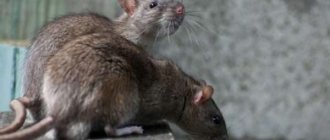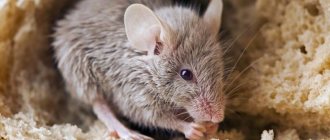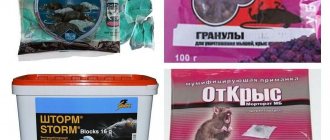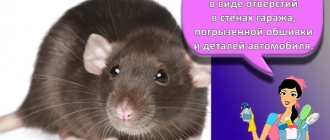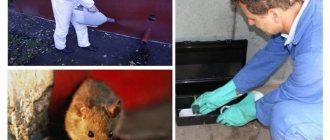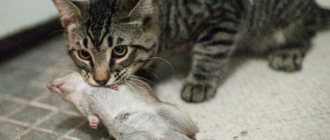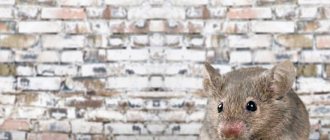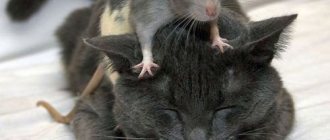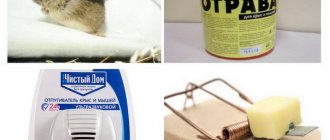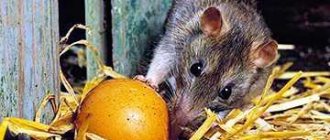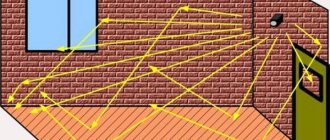Among the many pest control agents on the market today, it is not so easy for an unprepared person to make a choice in favor of one drug or another. Indeed, it is not always clear what is the best way to poison rats and mice in the house, so that the procedure is as effective as possible, and at the same time, simple and relatively safe for humans and pets.
Perhaps the first thing that is important to know here is that various rat poisons can differ quite significantly in their properties, and baiting rats with them requires taking into account the specifics of each product.
For example, of two drugs that seem to be similar in price - “Storm” and “Zookoumarin” - with one, baiting rats and mice will generally be much less troublesome than with the other. It often happens that a poison that is cheaper and widely available for sale turns out to be more effective and faster-acting than its expensive counterpart in beautiful packaging.
And a lot depends on the form of the product. For example, wax briquettes must be handled very carefully so that they do not absorb the smell of a person (if this is not done, then poisoning rats will be problematic, since they will simply bypass the bait). Poisons in the form of powders generate dust and are therefore dangerous, dough briquettes quickly become moldy and lose their odor in damp rooms, and poisoned grain attracts mainly only mice, but is often not so interesting to rats.
There are poisons that contain special bitters - rats and mice do not notice the bitter taste, and a dog or cat will not be able to swallow the bait, that is, treating rodents with such a drug will be more or less safe for pets.
On a note
There are other nuances. For example, today it has become fashionable to write on packages with poisoned baits about the so-called mummifying effect - they say that you can poison rats and mice without the risk of filling the room with the cadaverous smell of animals decomposing somewhere behind the wall or under the floor. Below we will talk more about whether mummifying drugs really exist and whether dead rodents actually turn into withered “mummies”.
When choosing a drug and its further use at home, it is important to pay attention to the active ingredient of the drug. This also has its own specifics, taking into account which you can significantly speed up the process of baiting rats and make it more effective...
What drugs are currently considered the most effective against rats?
In private houses, offices, apartments and in residential areas in general, it is almost always better to poison rats with agents based on blood anticoagulants. Such drugs are very effective, and there are still no known cases of rodents developing resistance to such active substances.
At the same time, the effect of blood anticoagulants is very specific, which sets them apart from other rat poisons:
- Anticoagulants disrupt the blood clotting mechanism in animals, and after accumulating a lethal dose (often with a single use) lead to the development of extensive internal hemorrhages, and with them the death of the pest;
- The agents act with a certain time delay - this increases the likelihood that the rat will feed on the bait several times and still receive its fatal portion;
- In addition, symptoms of poisoning do not develop in a rodent immediately; the rat does not associate them with poison, does not feel threatened by the bait, does not avoid it, and can even lead its wary fellows to the remedy.
All blood anticoagulants are divided into two groups, or two generations. Poisons based on second-generation anticoagulants are more effective, since the animal can (and usually eats) a portion of the product with a lethal dose of poison in one feeding, after which it dies within 4-5 days. A rat or mouse usually has to eat poison with first-generation anticoagulants at least 2 times, that is, baiting with these means lasts for a longer period, and in some cases the pests do not return to the bait and may not die.
Below are a few examples of the most popular rat poisons with blood anticoagulants today:
- Storm;
- Rat Death #1 and Rat Death #2;
- Nutcracker;
- Ratol;
- Zookoumarin Neo.
All of them are inexpensive, sold in markets and hardware stores in different packaging, including small bags that cost less than 100 rubles. For the needs of large enterprises, drugs can be purchased in buckets of several kilograms, but in order to poison rats in an apartment, private house or country house, minimal packaging is often sufficient.
On a note
According to experts, 16 grams of the same Storm (four briquettes of 4 grams each) is enough to poison rats in a living space of 50 square meters. m.
All drugs based on blood anticoagulants have their own characteristics, so let's look at the most common drugs in more detail.
Determination of arsenic.
A qualitative reaction to arsenic is the precipitation of yellow sulfide As2S3 from hydrochloric acid solutions. Traces are determined by the Marsh reaction or the Gutzeit method: strips of paper soaked in HgCl2 darken in the presence of arsine, which reduces sublimate to mercury.
In recent decades, various sensitive analytical methods have been developed that can quantify minute concentrations of arsenic, for example in natural waters. These include flame atomic absorption spectrometry, atomic emission spectrometry, mass spectrometry, atomic fluorescence spectrometry, neutron activation analysis... If there is very little arsenic in the water, pre-concentration of the samples may be necessary. Using such concentration, a group of Kharkov scientists from the National Academy of Sciences of Ukraine developed in 1999 an extraction-X-ray fluorescence method for determining arsenic (as well as selenium) in drinking water with a sensitivity of up to 2.5–5 μg/l.
For the separate determination of As(III) and As(V) compounds, they are first separated from each other using well-known extraction and chromatographic methods, as well as using selective hydrogenation. Extraction is usually carried out using sodium dithiocarbamate or ammonium pyrrolidine dithiocarbamate. These compounds form water-insoluble complexes with As(III), which can be extracted with chloroform. The arsenic can then be converted back into the aqueous phase by oxidation with nitric acid. In the second sample, arsenate is converted to arsenite using a reducing agent, and then a similar extraction is performed. This is how “total arsenic” is determined, and then by subtracting the first result from the second, As(III) and As(V) are determined separately. If there are organic arsenic compounds in water, they are usually converted to methyldiodarsine CH3AsI2 or dimethyliodarsine (CH3)2AsI, which are determined by one or another chromatographic method. Thus, using high-performance liquid chromatography, nanogram quantities of a substance can be determined.
Many arsenic compounds can be analyzed using the so-called hydride method. It involves the selective reduction of the analyte into volatile arsine. Thus, inorganic arsenites are reduced to AsH3 at pH 5 – 7, and at pH
The neutron activation method is also sensitive. It consists of irradiating a sample with neutrons, while 75As nuclei capture neutrons and transform into the radionuclide 76As, which is detected by characteristic radioactivity with a half-life of 26 hours. This way you can detect up to 10–10% arsenic in a sample, i.e. 1 mg per 1000 tons of substance
Storm
Today, Storm (Storm, manufactured by BASF), taking into account price, effectiveness and ease of use, can be considered one of the best drugs for baiting rats and mice in the house. The active ingredient of this drug, flocumafen, is one of the most effective blood anticoagulants.
A rat that eats this bait dies within 3-8 days (this period depends on how much of the product the pest ate the first time and how often it returned to the bait again). In fact, rodents disappear from the premises after 7-10 days, since they do not always find and eat poison on the first day.
Storm is produced by the largest German chemical concern BASF and is available in several packaging options:
- Packaging for 4 grams (1 briquette). Its price is about 15 rubles. A good option for an apartment or small house in which there is only one rat or mouse;
- A 16 gram package (4 briquettes) costs approximately 50 rubles. Allows you to poison rats in an apartment or, for example, the basement of a private house;
- A 50 gram package costs about 120 rubles. This option is well suited for a large private house in which a couple of dozen rodents need to be exterminated;
- 10 kg bucket with pellets or briquettes (briquettes can be 4 and 16 grams). Such a bucket costs about 10,000 rubles, and this volume is optimal for fighting rats in enterprises and in the basements of apartment buildings.
It is also useful to read: Poisons for rats and mice: a review of the most effective remedies
It is also important that the drug Storm is produced in the form of wax briquettes and pellets, which makes it especially convenient for use at home. Due to this molding, the bait is easier to dose, it does not generate dust and retains its attractiveness to mice and rats for a long time.
On a note
Storm's hard pellets may be more preferable to rat baiting than soft briquettes. The manufacturer specially produces such pellets with uneven sharp edges - this provokes animals to gnaw them when detected, even if the animal is not hungry. This behavior is typical of all rodents, since they need to constantly grind their teeth - they gnaw off protruding parts of various objects reflexively. This nuance increases the palatability of pellets and the effectiveness of the product.
Storm can be used against rats and mice only where children or pets cannot find it. If bullying is carried out in a residential area, it is advisable to send pets and children to relatives for the duration of treatment. As a last resort, you can use bait stations (they will be discussed below), but they do not provide a complete guarantee of safety, since pets can still find the poisoned pest.
On a note
Storm's analogue, Goliath, a remedy for rats, could have become its competitor, if not for one “but”: the drug is difficult to obtain and more expensive. Goliath can only be purchased in a few online stores; it is sold in large packages (in buckets) and costs almost one and a half times more than Storm. As a result, rats in houses are rarely poisoned with it.
Properties of arsenic.
Although arsenic looks like a metal, it is still rather a non-metal: it does not form salts, for example, with sulfuric acid, but is itself an acid-forming element. Therefore, this element is often called a semimetal. Arsenic exists in several allotropic forms and in this respect is very similar to phosphorus. The most stable of them is gray arsenic, a very brittle substance that, when freshly fractured, has a metallic sheen (hence the name “metallic arsenic”); its density is 5.78 g/cm3. When heated strongly (up to 615° C), it sublimes without melting (the same behavior is characteristic of iodine). Under a pressure of 3.7 MPa (37 atm), arsenic melts at 817 ° C, which is significantly higher than the sublimation temperature. The electrical conductivity of gray arsenic is 17 times less than that of copper, but 3.6 times higher than that of mercury. As the temperature increases, its electrical conductivity, like that of typical metals, decreases - to approximately the same extent as that of copper.
If arsenic vapor is very quickly cooled to the temperature of liquid nitrogen (–196 ° C), a transparent soft yellow substance is obtained, reminiscent of yellow phosphorus, its density (2.03 g/cm3) is significantly lower than that of gray arsenic. Arsenic vapor and yellow arsenic consist of As4 molecules in the shape of a tetrahedron - and here the analogy with phosphorus. At 800°C, noticeable dissociation of vapors begins with the formation of As2 dimers, and at 1700°C only As2 molecules remain. When heated and exposed to ultraviolet light, yellow arsenic quickly turns gray with the release of heat. When arsenic vapor condenses in an inert atmosphere, another amorphous form of this element, black in color, is formed. If arsenic vapor is deposited on glass, a mirror film is formed.
The structure of the outer electron shell of arsenic is the same as that of nitrogen and phosphorus, but unlike them, it has 18 electrons in the penultimate shell. Like phosphorus, it can form three covalent bonds (4s24p3 configuration), leaving a lone pair on the As atom. The sign of the charge on the As atom in compounds with covalent bonds depends on the electronegativity of neighboring atoms. The participation of a lone pair in complex formation is significantly more difficult for arsenic compared to nitrogen and phosphorus.
If d orbitals are involved in the As atom, pairing of 4s electrons is possible to form five covalent bonds. This possibility is practically realized only in combination with fluorine - in pentafluoride AsF5 (pentachloryl AsCl5 is also known, but it is extremely unstable and quickly decomposes even at –50 ° C).
In dry air, arsenic is stable, but in humid air it fades and becomes covered with black oxide. During sublimation, arsenic vapor easily burns in air with a blue flame to form heavy white vapor of arsenic anhydride As2O3. This oxide is one of the most common arsenic-containing reagents. It has amphoteric properties:
As2O3 + 6HCl ® 2AsCl3 + 3H2O,
2O3 + 6NH4OH ® 2(NH4)3AsO3 + 3H2O.
The oxidation of As2O3 produces an acidic oxide - arsenic anhydride:
As2O3 + 2HNO3® As2O5 + H2O + NO2 + NO.
When it reacts with soda, sodium hydroarsenate is obtained, which is used in medicine:
As2O3 + 2Na2CO3 + H2O ® 2Na2HAsO4 + 2CO2.
Pure arsenic is quite inert; water, alkalis and acids that do not have oxidizing properties do not affect it. Dilute nitric acid oxidizes it to orthoarsenic acid H3AsO3, and concentrated nitric acid oxidizes it to orthoarsenic acid H3AsO4:
3As + 5HNO3 + 2H2O ® 3H3AsO4 + 5NO.
Arsenic(III) oxide reacts similarly:
3As2O3 + 4HNO3 + 7H2O ® 6H3AsO4 + 4NO.
Arsenic acid is a medium-strength acid, slightly weaker than phosphoric acid. In contrast, arsenic acid is very weak, corresponding in strength to boric acid H3BO3. In its solutions there is an equilibrium H3AsO3HAsO2 + H2O. Arsenous acid and its salts (arsenites) are strong reducing agents:
HAsO2 + I2 + 2H2O ® H3AsO4 + 2HI.
Arsenic reacts with halogens and sulfur. AsCl3 chloride is a colorless oily liquid that fumes in air; hydrolyzes with water: AsCl3 + 2H2O ® HAsO2 + 3HCl. Bromide AsBr3 and iodide AsI3 are known, which also decompose with water. In the reactions of arsenic with sulfur, sulfides of various compositions are formed - up to Ar2S5. Arsenic sulfides dissolve in alkalis, in ammonium sulfide solution and in concentrated nitric acid, for example:
As2S3 + 6KOH ® K3AsO3 + K3AsS3 + 3H2O,
2S3 + 3(NH4)2S ® 2(NH4)3AsS3,
2S5 + 3(NH4)2S ® 2(NH4)3AsS4,
As2S5 + 40HNO3 + 4H2O ® 6H2AsO4 + 15H2SO4 + 40NO.
In these reactions, thioarsenites and thioarsenates are formed - salts of the corresponding thioacids (similar to thiosulfuric acid).
In the reaction of arsenic with active metals, salt-like arsenides are formed, which are hydrolyzed by water. The reaction occurs especially quickly in an acidic environment with the formation of arsine: Ca3As2 + 6HCl ® 3CaCl2 + 2AsH3. Arsenides of low-active metals - GaAs, InAs, etc. have a diamond-like atomic lattice. Arsine is a colorless, odorless, highly poisonous gas, but impurities give it the smell of garlic. Arsine decomposes slowly into elements already at room temperature and quickly when heated.
Arsenic forms many organoarsenic compounds, for example, tetramethyldiarsine (CH3)2As–As(CH3)2. Back in 1760, the director of the Serves porcelain factory, Louis Claude Cadet de Gassicourt, distilling potassium acetate with arsenic(III) oxide, unexpectedly received a fuming liquid containing arsenic with a disgusting odor, which was called alarsine, or Cadet's liquid. As it was later found out, this liquid contained the first obtained organic derivatives of arsenic: the so-called cacodyl oxide, which was formed as a result of the reaction
4CH3COOK + As2O3® (CH3)2As–O–As(CH3)2 + 2K2CO3 + 2CO2, and dicacodyl (CH3)2As–As(CH3)2. Kakodyl (from the Greek “kakos” - bad) was one of the first radicals discovered in organic compounds.
In 1854, Parisian chemistry professor Auguste Kaur synthesized trimethylarsine by the action of methyl iodide on sodium arsenide: 3CH3I + AsNa3® (CH3)3As + 3NaI.
Subsequently, arsenic trichloride was used for syntheses, for example,
(CH3)2Zn + 2AsCl3® 2(CH3)3As + 3ZnCl2.
In 1882, aromatic arsines were obtained by the action of metallic sodium on a mixture of aryl halides and arsenic trichloride: 3C6H5Cl + AsCl3 + 6Na ® (C6H5)3As + 6NaCl. The chemistry of organic derivatives of arsenic developed most intensively in the 20s of the 20th century, when some of them had antimicrobial, as well as irritant and blister effects. Currently, tens of thousands of organoarsenic compounds have been synthesized.
Rat Death #1 and #2
These two drugs are similar in their effectiveness and rules of use. The active ingredient of Rat Death No. 1 is brodifacoum, and that of Rat Death No. 2 is bromadiolone. Both of these substances belong to the second generation blood anticoagulants, both are approximately the same in toxicity for rats, but brodifacoum is more dangerous for the environment (this is partly due to the appearance of Rat Death No. 2 - in order to comply with environmental standards, the manufacturer needed to switch to a more environmentally friendly active ingredient, preserving product effectiveness).
The drugs are sold at the same price: approximately 70 rubles per 100 gram package (8 briquettes), or 120 rubles per 200 gram package (16 briquettes).
Perhaps the main disadvantage of the product compared to Storm is that it is produced in the form of soft test briquettes. Such briquettes dry out relatively quickly in residential areas and sometimes become moldy. Therefore, it is better to poison rodents with Rat Death in small apartments and private houses, where there are few pests, and they will relatively quickly find and eat the poison.
Review:
“We also use rat death 1. Rats usually die within a week. And everything would be fine, but only after this a terrible stench always appears in our apartment. As I understand it, it’s the dead animals that are starting to decompose... With us, they always die in hard-to-reach places, and always in different ones. And it’s unclear where, either behind the wall, or somewhere under the floor. Either in the bathroom or in the hallway we smell this stench. And fleas appear and flies fly to the smell. But we are forced to endure, since neither cats nor mousetraps help, only poison ... "
Oksana, Moscow
Release forms
There are different poisons that can be used to poison mice and rats. Both concentrated preparations for preparing baits yourself and ready-made products are available. They are produced in the form of briquettes, granules, gels, processed grains and seeds, powders, flakes, liquids, pastes.
It is important to know! Any bait must be placed in places inaccessible to children and pets.
Blocks
Most often, it is foreign manufacturers who produce baits in the form of solid nodules - blocks. They can be large or small, with or without holes for threading onto rods.
Granules
The crushed grain mixture with the addition of a chemical is formed by an extruder into solid granules, similar to compound feed or dry dog food. This form is preferred by mice, although rats will also eat them.
Bruschi
Ready-to-use solid nodules in the form of bars usually have foreign preparations. Manufacturers recommend placing them in special stations.
Corn
Crushed or whole grains, cereals, and their mixtures are coated with poison and painted in bright colors. This form is more suitable for poisoning mice.
Liquid poison
Liquid solutions of active ingredients in water, oil, alcohol or ethylene glycol are more effective in fighting rats, especially if there are no easily accessible sources of water nearby. But there is not always such a hard-to-reach place where a saucer or bowl will fit.
Gel
The rodenticide in the form of a gel is produced in two types:
- ready-to-use drug;
- concentrate for making your own baits.
Effective against rats, mice and voles. The ready-to-use drug may leave marks on the surface to which it was applied. Therefore, it is recommended to place it on substrates made of thick paper, polyethylene, or plastic.
Powders
The powders consist of wheat, oat or barley flour mixed with a blood anticoagulant and a small amount of sugar. They are effective for most objects, but you need to prepare poisoned baits yourself. When mixed, they generate dust, and this is dangerous for humans, so they must be handled with extreme caution.
Soft briquettes
The texture of soft briquettes resembles dense dough. Rats like them because they look like meat. Convenient to use. They are painted in bright colors, distinguishing them from ordinary food products.
Interesting! Rats usually have a preference for animal products.
Remedy for rats and mice Nutcracker
The rodent repellent Nutcracker is an analogue of Rat Death No. 1 in terms of the active substance, but it has a nuance: bitterness has been added to the product, which prevents accidental consumption of the poison by pets (primarily cats and dogs) and children. However, this does not make the drug completely safe to use: the fact is that the same cat can find and eat a poisoned rat - this must be taken into account and it is imperative to collect and destroy the found corpses of poisoned rodents.
However, if used carefully and in accordance with the instructions, the Nutcracker is quite suitable for baiting rats and mice in apartments and houses.
The price of the drug is approximately 50 rubles for a package of 100 grams, 100 rubles for 200 grams, about 200 rubles for 500 grams. The Nutcracker is also available in packaging for professional use - in buckets of 1.5 and 10 kilograms.
On a note
The closest analogues of the products described above are Ratol (the active ingredient is difenacoum, a drug similar in properties to Storm, also produced by BASF, but sold only in large packaging), Zookoumarin Neo (contains bromadiolone and a first-generation anticoagulant - zoocoumarin) and some other drugs. They are also suitable for baiting rats and mice at home.
Rules for the use of poisons
Having decided on a poison for a rodent, you need to strictly follow the instructions offered by the manufacturer. If all recommendations are followed, the pests will die in 1–10 days (it all depends on the type of product used). Regardless of the chosen method of getting rid of mice indoors, it is important to follow a number of rules:
- You should take care of your own safety and wear a protective suit and gloves when laying out poisons;
- when spraying toxic aerosols, it is recommended to clear the room of pets, take away family members for several days and first put on a protective suit and respirator;
- toxic compounds should not be poured directly onto the floor; it is better to place them on plastic stands;
- containers with poisoned bait should be placed in places where rodent burrows are supposed to be located;
- The carcasses of dead animals must be removed immediately. If you ignore searching for dead mice around the house, you may suffer from the appearance of a pungent, corpse-like odor.
In the fight against mice, the best assistant will be modern poisons based on anticoagulants, which do not cause suspicion in rodents and are practically not dangerous to humans. By following personal safety rules and promptly removing the corpses of dead mice, you can quickly and easily cope with their appearance.
Fighting order: how to properly poison rats in the house
Poisoning rats in a house or apartment is not difficult, but this procedure requires compliance with several rules in order to obtain maximum results with the least hassle.
Firstly, the poison is laid out where rats or mice can quickly find it, that is, in places where rodents are likely to be. Such places can be identified by droppings, food remains, chewed materials, and in basements - by digging and traces in the dust.
Often, the owners of the house are well aware of where rats most often scurry around and where they look for food (for example, near the trash can, stocks of vegetables and cereals in the room). This is where the poison should be placed in a visible place.
On a note
It is enough to place one briquette (or a small pile of poisoned grain) in each place. The rat may not eat the entire portion of the bait, but even a small amount is often enough for the animal to become poisoned. It is irrational to place 2-3 briquettes nearby at once - it will be more effective if you place them one at a time in different places.
Secondly, all briquettes need to be checked once every 1-2 days. Those baits that the rats have eaten completely or dragged somewhere are replaced with new ones - and so on until the pests stop eating the poison.
It is also useful to read: What sound can scare away rats from the house
Thirdly, if there are children in the house, the poison should be placed in bait boxes - any boxes that have holes for rats, but from which a child cannot get the contents. This will be a sufficient guarantee of safety.
Fourth, rodents (especially rats) are very sensitive to human odor if it comes from bait. Therefore, all work with drugs should be carried out with gloves (this will also protect against poison getting on the skin of your hands).
If after several eating all the baits remain untouched for more than 2-3 days, it makes sense to place them in new places, and if the rodents do not eat them there either, then all the briquettes can be removed. This situation means that there are no longer any living rats and mice left in the house.
Finally, poisoned rats will die and decompose somewhere, often right here in the house, and this is a big problem. The “mummifying” agents advertised on many websites, after poisoning with which rodents supposedly do not decompose, but simply dry out, are nothing more than an advertising ploy by sellers. None of the rat poisons known today has such a mummifying effect, which means there is always a risk that a dead rat (or rats) will decompose indoors.
If there are places in the house from which the corpse of a pest cannot be removed (for example, ducts of ventilation systems, cavities behind drywall), then it may make sense to use other means instead of poisons.
Historical information.
Also on the topic:
ARSENIC AND HUMAN HEALTH
Arsenic belongs to the five “alchemical” elements discovered in the Middle Ages (surprisingly, four of them - As, Sb, Bi and P - are in the same group of the periodic table - the fifth). At the same time, arsenic compounds have been known since ancient times; they were used to produce paints and medicines. Particularly interesting is the use of arsenic in metallurgy.
Several thousand years ago, the Stone Age gave way to the Bronze Age. Bronze is an alloy of copper and tin. Historians believe that the first bronze was cast in the Tigris-Euphrates valley, somewhere between the 30th and 25th centuries. BC. In some regions, bronze with especially valuable properties was smelted - it was better cast and easier to forge. As modern scientists have found, it was a copper alloy containing from 1 to 7% arsenic and no more than 3% tin. Probably, at first, during its smelting, the rich copper ore malachite was confused with the weathering products of some also green sulfide copper-arsenic minerals. Having appreciated the remarkable properties of the alloy, the ancient craftsmen then specifically looked for arsenic minerals. For the search, we used the property of such minerals to give off a specific garlic odor when heated. However, over time, the smelting of arsenic bronze ceased. Most likely this happened due to frequent poisoning during the firing of arsenic-containing minerals.
Of course, arsenic was known in the distant past only in the form of its minerals. Thus, in Ancient China, the solid mineral realgar (sulfide with the composition As4S4, realgar in Arabic means “mine dust”) was used for stone carving, but when heated or exposed to light, it “deteriorated” as it turned into As2S3. In the 4th century. BC. Aristotle described this mineral under the name "sandarac". In the 1st century AD The Roman writer and scientist Pliny the Elder, and the Roman physician and botanist Dioscorides described the mineral orpiment (arsenic sulfide As2S3). Translated from Latin, the name of the mineral means “golden paint”: it was used as a yellow dye. In the 11th century alchemists distinguished three “varieties” of arsenic: the so-called white arsenic (As2O3 oxide), yellow arsenic (As2S3 sulfide) and red arsenic (As4S4 sulfide). White arsenic was obtained by sublimation of arsenic impurities during the roasting of copper ores containing this element. Condensing from the gas phase, arsenic oxide settled in the form of a white coating. White arsenic has been used since ancient times to kill pests, as well as...
In the 13th century Albert von Bolstedt (Albert the Great) obtained a metal-like substance by heating yellow arsenic with soap; This may have been the first example of arsenic in the form of a simple substance obtained artificially. But this substance violated the mystical “connection” of the seven known metals with the seven planets; This is probably why alchemists considered arsenic a “bastard metal.” At the same time, they discovered its property of giving copper a white color, which gave rise to calling it “a Venus (i.e. copper) bleaching agent.”
Arsenic was clearly identified as an individual substance in the mid-17th century, when the German pharmacist Johann Schroeder obtained it in a relatively pure form by reducing the oxide with charcoal. Later, the French chemist and physician Nicolas Lemery obtained arsenic by heating a mixture of its oxide with soap and potash. In the 18th century arsenic was already well known as an unusual "semi-metal". In 1775, the Swedish chemist K.V. Scheele obtained arsenic acid and gaseous arsenous hydrogen, and in 1789 A.L. Lavoisier finally recognized arsenic as an independent chemical element. In the 19th century Organic compounds containing arsenic were discovered.
How to poison rats using professionals and sanitary services
What should you do if you don’t want to poison rats yourself, or are afraid to use powerful poison in your own home without proper preparation? In such cases, rodent baiting services can come to the rescue.
The procedure itself is officially called deratization - in Moscow, St. Petersburg and other large cities it can be carried out by many companies specializing in pest control in general (insects, moles, rodents, birds, etc.). The specialists of these services poison rats and mice with professional drugs, and often use the aforementioned Storm and Ratol. If the owner of the premises does not want chemicals to be used in his house, then specialists do not treat the premises, but catch rodents with traps.
As a rule, the services of a good pest control service start at 2,500 rubles for baiting rats in a small house. The price depends on the size of the premises, the number of rats in it, the need to travel outside the city, as well as on the guarantees provided by the company.
Meanwhile, municipal sanitary services must poison rats and mice in an apartment building, and the management company must organize this process. As a rule, rat baiting in the basements of city houses is carried out according to a schedule (usually in the summer) and does not require any effort on the part of the residents of the house.
However, if rats wander around the entrance, climb onto balconies and even into apartments, you need to write a statement to the SES (it is enough to write it in any form, a sample is not required) and to the management company. It’s good if such a complaint is collective, from many residents of the house at once - in this case it will be considered faster.
Review:
“There was a problem with rats at work. Not only did they chew the bags, but they also littered the food. I’ve never encountered this problem before, I didn’t want to use chemicals myself, and otherwise I don’t even know how to get rid of this evil spirits. We started looking for someone to carry out this etching. As a result, they called a private pest control service. Good organization, the guys came twice, laid out bait and traps, sealed holes in the walls, and left a whole manual on how to protect the warehouse from rodents. Now we have signed an agreement with them for constant service; there are no rats or mice in the warehouse or in the stores...”
Oleg, Makhachkala
How to prepare poison for mice at home that is safe for other animals
You can make poison for uninvited guests yourself, using improvised means . These baits will be completely safe for humans and pets.
You can make poison for uninvited guests yourself, using improvised means.
Their action is not as fast as that of chemical drugs, so you can completely get rid of mice in several procedures.
Recipes for preparing poison.
- Mix buckwheat with alabaster in a ratio of 1:3. Place a container of water next to the bait. After a meal, the rodent will want to drink, which will lead to swelling of the alabaster inside.
- Combine sugar with quicklime in a 1:2 ratio. Rodents will not ignore the sweet powder, and when lime reacts with moisture, gases will begin to be released, the temperature will rise and the stomach will swell. This will lead to inevitable death.
- Mix gypsum with corn flour in equal quantities. Add a little warm milk to the mixture to form a stiff dough. Roll the resulting mass into balls and place them in rodent habitats. The plaster in the stomach will harden and clog the rodent's intestines.
How to get rid of rats without poison
Finally, you can get rid of rats without poison, and often such a fight can be even more effective than using poisons.
So, as an alternative to poisons, you can use:
- Traps (as a rule, ordinary rat traps and crushers are used). They are good because one trap can catch tens and hundreds of rats, if necessary, without any additional financial costs. However, traps have their drawbacks: they are more troublesome to use than poison, and pose some danger to children and pets (in particular, a rat trap can easily break a cat's paw). But, perhaps, the most unpleasant thing is that you will have to regularly remove an animal with crushed bones, and sometimes fluttering, from the rat trap;
- Live traps are completely safe, but they are just as effective as traps. Their main disadvantage is the need to do something with a caught rat - either kill it, or take it far outside the premises and release it. It's troublesome. On the other hand, you can make live traps with your own hands, sometimes it’s faster, more effective and even easier than buying poison or industrially produced traps;
- Another option is a cat or rat-catcher, you can borrow it from neighbors or relatives and lock it in a room with rats. Often this particular method of fighting rats turns out to be simpler and more effective than all others;
- Electronic rat repellers - in some cases, they actually help repel rodents. But the disadvantage of such devices is that you can never know in advance whether the device will work against rats in a particular house or not. At the same time, repellers are quite expensive and, in addition, not only rodents, but also pets can react sharply to them.
However, poisons are good because, with the right approach, they allow you to poison a large (sometimes huge) number of rats in a short period of time and with minimal labor costs. If you take into account the peculiarities of using poisoned baits, you can use them to get rid of pests in almost any room.
Review of the poison Rat Death No. 1
Obtaining arsenic.
Arsenic is obtained mainly as a by-product of the processing of copper, lead, zinc and cobalt ores, as well as during gold mining. Some polymetallic ores contain up to 12% arsenic. When such ores are heated to 650–700° C in the absence of air, arsenic sublimes, and when heated in air, volatile oxide As2O3 is formed - “white arsenic”. It is condensed and heated with coal, and arsenic is reduced. Producing arsenic is a harmful production. Previously, when the word “ecology” was known only to narrow specialists, “white arsenic” was released into the atmosphere, and it settled on neighboring fields and forests. The exhaust gases from arsenic plants contain from 20 to 250 mg/m3 As2O3, while the air usually contains approximately 0.00001 mg/m3. The average daily permissible concentration of arsenic in the air is considered to be only 0.003 mg/m3. Paradoxically, even now it is not the factories that produce arsenic that pollute the environment much more heavily, but non-ferrous metallurgy enterprises and power plants that burn coal. Bottom sediments near copper smelters contain huge amounts of arsenic – up to 10 g/kg. Arsenic can also enter the soil with phosphorus fertilizers.
And another paradox: they receive more arsenic than is required; This is quite a rare case. In Sweden, “unnecessary” arsenic was even forced to be buried in reinforced concrete containers in deep abandoned mines.
The main industrial arsenic mineral is arsenopyrite FeAsS. There are large copper-arsenic deposits in Georgia, Central Asia and Kazakhstan, the USA, Sweden, Norway and Japan, arsenic-cobalt deposits in Canada, and arsenic-tin deposits in Bolivia and England. In addition, gold-arsenic deposits are known in the USA and France. Russia has numerous arsenic deposits in Yakutia, the Urals, Siberia, Transbaikalia and Chukotka.
Folk remedies
Often, an invasion of a mouse population is observed not only in residential buildings, but also on a personal plot. The mouse greatly pollutes the surrounding area and destroys the harvest stored for the winter.
It is imperative to get rid of mice, since rodents cause the development of diseases of the respiratory system and often provoke allergies. Animals carry dangerous infections that can affect pets and even people.
An effective remedy for mice in the countryside is to plant and use plants that mice cannot tolerate. Their aroma will force the animal to leave the territory.
Peppermint
To get rid of tailed pests, plant peppermint in your yard. Use the essential oil of this plant inside your home. You can form cotton balls and soak them in peppermint oil. Place a kind of natural repellent where rodents are active. The product is quite effective and safe for human health and pets.
At the dacha in winter, you can spread peppermint herb in the corners of the house and basement, and hang a bouquet inside the cellar and barn. The mint smell is unpleasant to rodents. They will try to avoid places where peppermint is found. It is also worth preparing mint water.
To do this, take a little mint oil, water, 10 ml of alcohol. The ingredients are mixed and the mixture is added to an aerosol can. Spray mint water throughout the room and basement.
Sagebrush
An excellent remedy against rats and mice is wormwood. It has an aroma that makes rodents leave the garden. Wormwood smells very unpleasant to mice. Rodents cannot stand the strong smell of grass and leave their homes. They leave any garden plot in the beds of which wormwood grows in abundance.
Wormwood herb has effective healing properties. Therefore, its cultivation in a personal plot will be useful for adherents of traditional medicine. Wormwood treats diseases of the digestive tract, stops bleeding and colds. This natural antiseptic is extremely beneficial for human health.
If you don’t like the strong smell of wormwood, an alternative is elderberry. You can plant this plant in your dacha and forget about the invasion of tailed pests forever.
Other bitter herbs can also repel mice, and cotton pads or rags should be soaked in essential oils. Place the products in the corners along with fresh herbs.
Coriander
The method of repelling pests with a pungent herbal smell has been used in Rus' for a long time. Mice cannot stand the aroma of spices. Naturally, this method does not kill the animals, but only scares them away and forces them to leave the house and garden.
In the premises of houses, in the private sector, it is effective to scatter coriander to scare away animals. If the rodent has taken a fancy to the pantry or balcony, place bunches and coriander fruits on the shelves and on the floor in the corners. The smell of spice will scare away the animals and force them to leave the room.
Coriander fruits contain a large amount of essential oil. The spice also contains acids that are beneficial to human health. If a mouse has visited your home, you should use coriander not only for food. To combat rodents, you can purchase coriander essential oil. It is added to water and sprayed from an aerosol can indoors.
Controlling tailed pests can be very effective if several methods are used simultaneously. You can install an electronic repeller and at the same time spray mint water.
The mouse has a very sensitive sense of smell and acute hearing. The animal will not be able to physically endure the sound vibrations of the device and at the same time will suffer from a pungent odor in the environment. This combined method will help get rid of mice in the house forever and will not cause harm to pets and residents.
Whatever method of pest control is chosen, it is important to consider the degree of toxicity of the product, its benefits and harm to human health.
Application
Arsenic is used to alloy lead alloys used to prepare shot, since when shot is cast using the tower method, drops of the arsenic-lead alloy acquire a strictly spherical shape, and in addition, the strength and hardness of lead increases significantly.
Arsenic of special purity (99.9999%) is used for the synthesis of a number of useful and important semiconductor materials - arsenides (for example, gallium arsenide) and other semiconductor materials with a crystal lattice such as zinc blende.
Arsenic sulfide compounds - orpiment and realgar - are used in painting as paints and in the leather industry as agents for removing hair from the skin.
In pyrotechnics, realgar is used to produce “Greek” fire or “Indian” (Bengal) fire, which occurs when a mixture of realgar with sulfur and nitrate burns (when burned, it forms a bright white flame).
Some organoelement compounds of arsenic are chemical warfare agents, for example, lewisite.
At the beginning of the 20th century, some cacodyl derivatives, for example, salvarsan, were used to treat syphilis; over time, these drugs were displaced from medical use for the treatment of syphilis by other, less toxic and more effective, pharmaceutical drugs that do not contain arsenic.
Many of the arsenic compounds in very small doses are used as drugs to combat anemia and a number of other serious diseases, as they have a clinically noticeable stimulating effect on a number of specific functions of the body, in particular, on hematopoiesis. Of the inorganic arsenic compounds, arsenous anhydride can be used in medicine for the preparation of pills and in dental practice in the form of a paste as a necrotizing drug. This drug was colloquially and colloquially called “arsenic” and was used in dentistry for local necrosis of the dental nerve (see pulpitis). Currently (2015), arsenic preparations are rarely used in dental practice due to their toxicity. Now other methods of painless necrosis of the tooth nerve under local anesthesia have been developed and are being used.
COMBAT MEASURES
The first step in controlling these pests is to inspect your fields in the spring (unless, of course, your concern is only in storage areas). If you find more than 100 holes per 1 hectare in a field, this is a real signal that you need to start fighting them, since this indicator indicates the economic limit of harmfulness. Old methods of control are chemical (traps) and biological (attracting natural enemies). Both are still widespread today. True, poisoned traps are now made from new substances and scattered even using the aerial method. And instead of a domestic cat for field conditions in Japan, for example, even the Japanese ferret (Mustela itatsi) was involved in the fight against mouse-like animals.
Chemicals
Chemicals for mice control
These are perhaps the most common means, since they are the ones that have the maximum effectiveness, reaching almost 100%. They are based on the so-called. rodenticides are special chemicals used to control rodents. Rodenticides can be of natural or synthetic origin.
All rodenticides are highly toxic and pose a danger to humans and pets. They should be used with caution and in full accordance with the instructions!
There are different forms of release of chemicals:
- powders
- aerosols
- briquettes
- sugar mixtures (lozenges, candies, etc.)
- poison-treated seeds (sunflower, wheat, etc.)
- pastes
- etc.
Krysin
Rat remedy
Krysin
A broad-spectrum drug that works against all types of mice, as well as gray and black rats. The standard form of release is briquettes; also sold in gel form. The active substance of the drug is the second generation rodenticide brodifacoum at a concentration of 0.005%. The briquette also contains food filler and flavoring. Krysin is available in packages of 100 g, 5 kg and 10 kg.
The active substance of the drug, brodifacoum, is an intestinal pesticide and a blood coagulant. Death of rodents from suffocation occurs within 3-15 days from the moment the product enters the stomach.
But the drug practically does not react with atmospheric moisture, so it can be used in dry and damp rooms. The shelf life of the product is 1 year.
In areas where rodents are active, all sources of liquid should be removed, since if the mouse drinks a few minutes after taking the drug, its effectiveness will be significantly reduced.
Brodifan
Liquid concentrate Brodifan
Brodifan
It is a liquid product that is used for making bait yourself. The main active ingredient is brodifacoum in high concentration (0.25%). To create 1 kg of poison you will need only 20 g of Brodifan.
The bait should be placed in areas where rodents are active in an amount of 10 g per 1 square meter. As the rodents eat the bait, new portions must be added throughout the week.
A high concentration of the toxic substance leads to the fact that on the 4th day mice begin to show anxiety and crawl out of their holes into fresh air because they experience breathing problems. The rodents' movements become sluggish and within a few days they die from suffocation.
Testox
Testox product
Testox
A universal remedy against rats and mice. The mortality rate of the latter is 100%. The active substance is bromadialone at a concentration of 0.005%.
The poison is in the form of red briquettes weighing 10 g. A flavoring with the taste of peanuts, cheese, vanilla or sunflower is added to the briquettes.
Testox is laid out in places where rodents are active, 2-5 briquettes at one point. The distances between bookmarks vary from 2 to 15 m. Bookmarks are updated every 1-2 days during the week.
The effect of the drug is similar to those discussed earlier. On the 3-4th day, rodents begin to show anxiety and come out of hiding. After a few more days, they die from paralysis of the respiratory muscles.
Warat bait
Warat bait
Warat bait
Granular bait with a small fraction of pale pink color. Used primarily against mice. Can be used both indoors and for treating garden plots.
The active substance is brodifacoum (concentration 0.005%). The product should be placed in small containers of 10-15 g per point. Bookmarks in rooms are made with a consumption of 10-20 g per 1 sq. m., bookmarks in gardens or vegetable plots - up to 2 kg per hundred square meters or 8 g per mouse hole. The interval between bookmark updates is 1-2 weeks. Death of rodents occurs within 2-3 weeks.
Lanirat
Lanirat packaging
Lanirat
A chemical based on bromadialone (concentration 0.0055%). It is a grain bait treated with an active substance. The grains used are wheat or sunflower.
The product can be used both indoors and outdoors. Application rates indoors range from 10 to 50 g per planting, in the garden or vegetable garden - up to 10-15 g per hole or about 0.2-0.3 kg per hundred square meters.
Rodent mortality occurs within 10 days. Lures are updated daily.
Drug Storm
Appearance of solid briquettes Storm
Drug Storm
German product from BASF. One of the best remedies currently. The active ingredient is flocumafen at a concentration of 0.005%. Produced in the form of blue briquettes with light inclusions.
An extremely effective product. For one residential premises with an area of up to 100 sq. m. You only need 1 or 2 briquettes. They should be placed in areas where rodents come from. The bait has a strong attracting effect, so there should be no problems with attracting rodents. Moreover, the manufacturer does not recommend laying out too many baits to avoid the arrival of rodents from other places.
Lures are updated every 1-2 days. Untouched baits are transferred to new places. The manufacturer guarantees the destruction of rodents within a week.
The storm is extremely toxic. You can only work with it while wearing gloves. You should also avoid inhaling its vapors for too long.

